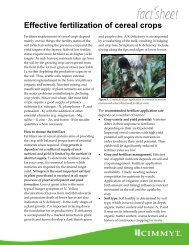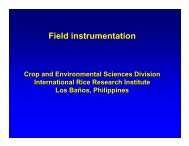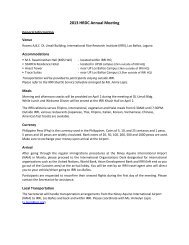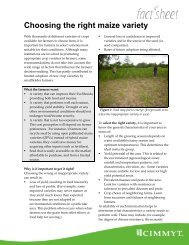Water management in irrigated rice - Rice Knowledge Bank ...
Water management in irrigated rice - Rice Knowledge Bank ...
Water management in irrigated rice - Rice Knowledge Bank ...
- No tags were found...
You also want an ePaper? Increase the reach of your titles
YUMPU automatically turns print PDFs into web optimized ePapers that Google loves.
<strong>Water</strong> reuse (10 6 m 3 )100908070605040302010005,000 10,000 15,000 20,000Area (ha)y = 0.0046x + 0.8885R 2 = 0.9049y = 0.0013x + 1.1412R 2 = 0.9174Fig. 5.2. Volume of reuse of surface water by check dams( ) and by groundwater pump<strong>in</strong>g ( ) versus spatial scale <strong>in</strong>District I of UPRIIS. The l<strong>in</strong>es are l<strong>in</strong>ear regressions. Datafrom Hafeez (2003).<strong>Water</strong> productivity (g gra<strong>in</strong> kg –1 water)0.200.180.160.140.120.100.080.060.040.020.000y = (7 × 10 –6 )x + 0.0561R 2 = 0.8465,000 10,000 15,000 20,000Area (ha)Fig. 5.3. <strong>Water</strong> productivity (WP IR; g <strong>rice</strong> gra<strong>in</strong>s kg –1 watersupplied (irrigation plus ra<strong>in</strong>fall)) versus spatial scale <strong>in</strong>District I of UPRIIS. The l<strong>in</strong>e is a l<strong>in</strong>ear regression. Theabsolute values of WP IRare low (compare with values <strong>in</strong>Chapter 1.5) because a lot of water still flows out of the area(dra<strong>in</strong>age water) but is reused by downstream irrigators. Datafrom Hafeez (2003).Recent studies of <strong>rice</strong>-based irrigation systems<strong>in</strong> Ch<strong>in</strong>a and the Philipp<strong>in</strong>es <strong>in</strong>dicate that manywater performance <strong>in</strong>dicators (such as water productivity,fraction of applied water used by the crop)improve with <strong>in</strong>creas<strong>in</strong>g spatial scale because of thereuse of water (Hafeez 2003, Loeve et al 2004a,b).Much of this reuse is done <strong>in</strong>formally by farmerswho take their own <strong>in</strong>itiative to pump water, blockdra<strong>in</strong>age waterways, or construct small on-farm reservoirsfor secondary storage. Most of these farmersare found <strong>in</strong> tail-end portions of irrigation systemswhere water does not reach because too much wateris lost upstream (e.g., by upstream farmers tak<strong>in</strong>gtoo much water, by canal seepage losses, and byoperational losses). Hafeez et al (2007) reportedquantitative data on water reuse on 18,000 ha ofDistrict I of the <strong>rice</strong>-based Upper Pampanga RiverIntegrated Irrigation System (UPRIIS) <strong>in</strong> CentralLuzon, Philipp<strong>in</strong>es. A total of 16 check dams werefound for reuse of surface dra<strong>in</strong>age water, and12% of all farmers owned a pump for groundwaterextraction. In the whole study area, 57% of all availablesurface water was reused by the check damsand 17% through pump<strong>in</strong>g. The amount of waterpumped from the groundwater was about 30% ofthe groundwater recharge by percolation from <strong>rice</strong>fields. Figure 5.2 shows that the amount of waterreused by the check dams and by pump<strong>in</strong>g <strong>in</strong>creasedwith spatial scale (because, with <strong>in</strong>creas<strong>in</strong>g scale,the options for reuse <strong>in</strong>crease). Because of this<strong>in</strong>crease <strong>in</strong> water reuse with <strong>in</strong>creas<strong>in</strong>g scale, thewater productivity <strong>in</strong>creased with spatial scale aswell (Fig. 5.3).Although water can be efficiently reused thisway, it does, however, come at a cost, especiallyto downstream farmers. The current debate on theimprovement of irrigation systems focuses on therelative benefits and costs of system modernizationvis-à-vis those of <strong>in</strong>ternal and (mostly <strong>in</strong>formal)reuse of water. System modernization aims to improvethe irrigation system delivery <strong>in</strong>frastructureand operation scheme to supply each farmer withthe right amount of water at the right time. Ga<strong>in</strong>s<strong>in</strong> water productivity are possible by provid<strong>in</strong>gmore reliable irrigation supplies, for example,through precision technology and the <strong>in</strong>troductionof on-demand delivery of irrigation supplies (e.g.,Gleick 2000, Rosegrant 1997). The argument isthat when farmers have control over tim<strong>in</strong>g andamount of water supplies to their farm, they neednot take their turn <strong>in</strong> a fixed rotational scheduleof deliveries if the soil is still wet from ra<strong>in</strong>fall.Match<strong>in</strong>g system delivery and field-level demandneeds further research, as optimal schedul<strong>in</strong>g ofirrigations is difficult when a large part of the cropwater requirement is met from ra<strong>in</strong>fall. This isespecially true <strong>in</strong> large irrigation systems with aconsiderable time lag between diversion of waterat the source (river or reservoir) and its arrival atthe farmer’s gate. In some parts of Ch<strong>in</strong>a, although40





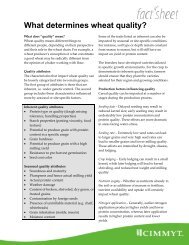

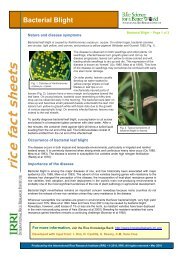

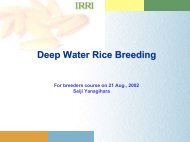
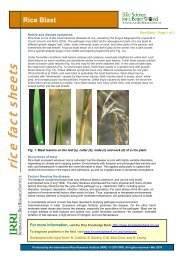
![International Standards' Organization â Rice Specification [ISO 7301]](https://img.yumpu.com/36696862/1/190x245/international-standards-organization-a-rice-specification-iso-7301.jpg?quality=85)

